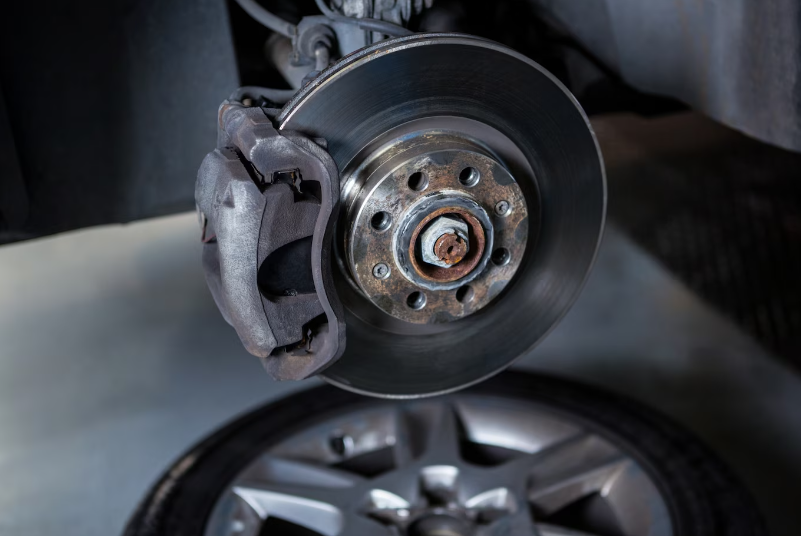Navigating Brake Replacement Front vs Rear Brakes

When it comes to brake replacement, it’s important to understand the difference between front and rear brakes. Your vehicle’s braking system is crucial for your safety on the road, and replacing worn-out brakes in a timely manner is essential to maintain optimal performance.
Front Brakes:
The front brakes play a critical role in stopping your vehicle. As the weight of the car shifts forward during braking, the front brakes bear the brunt of the workload. This means that they tend to wear out faster compared to the rear brakes. However, front brake pads are generally easier and more affordable to replace, making it a relatively simple maintenance task.
Front brakes not only provide the majority of stopping power, but they also contribute to improved handling and control. With well-maintained front brakes, you can confidently navigate sharp turns and sudden stops.
Key Points:
– Front brakes bear the brunt of the workload during braking
– Front brake pads are easier and more affordable to replace
– Well-maintained front brakes contribute to improved handling and control
Rear Brakes:
The rear brakes, although less prone to wear compared to the front brakes, still play an important role in the overall braking system. These brakes help to stabilize the vehicle during braking, preventing skidding or loss of control.
Since the weight of the vehicle shifts forward during braking, the rear brakes offer additional stopping power. While they may not wear out as quickly as the front brakes, it’s crucial to monitor their condition and replace them when necessary. Neglecting rear brake maintenance can lead to decreased stopping power and potential safety hazards.
Key Points:
– Rear brakes help stabilize the vehicle during braking
– Rear brakes offer additional stopping power
– Neglecting rear brake maintenance can lead to decreased stopping power and safety hazards
When it comes to brake replacement, it’s important to consider both the front and rear brakes. Properly functioning brakes are essential for your safety and the safety of others on the road. By understanding the differences between front and rear brakes and staying proactive with maintenance, you can ensure optimal performance and peace of mind behind the wheel.
Optimal Brake Replacement Strategies
When it comes to brake replacement, it’s important to have a strategy in place to ensure optimal performance and safety. There are several factors to consider when deciding whether to replace the front or rear brakes.
1. Wear and Tear: Both the front and rear brakes experience wear and tear over time. However, the front brakes typically wear out faster due to the weight distribution of the vehicle during braking. It’s important to monitor the condition of both sets of brakes and replace them as necessary.
2. Symptom Analysis: Paying attention to any symptoms of brake issues can help determine which set of brakes needs replacement. If you notice squeaking or grinding noises, vibrations or pulsations while braking, it’s likely that the front brakes are due for replacement. On the other hand, if you experience a loss of braking power or your vehicle pulls to one side, it may be time to replace the rear brakes.
3. Maintenance Considerations: Front and rear brakes may require different maintenance procedures. For example, front brakes often require more frequent rotor resurfacing or replacement compared to rear brakes. Understanding the specific maintenance requirements can help you develop a more effective brake replacement strategy.
4. Budget Allocation: Considering your budget is also an important factor in deciding which brakes to replace. If you’re on a tight budget, you may choose to replace the front brakes first since they tend to wear out faster. However, it’s important to remember that neglecting the rear brakes can compromise your vehicle’s overall braking performance and safety.
Overall, the key to optimal brake replacement strategies is to regularly monitor the condition of both the front and rear brakes, pay attention to any symptoms of brake issues, understand the specific maintenance requirements, and allocate your budget accordingly. By taking a proactive approach, you can ensure that your brakes are always in top shape, providing you with the peace of mind and confidence you need on the road.
Front Brakes
When it comes to brake replacements, the front brakes are a crucial component of your vehicle’s braking system. They play a significant role in stopping your vehicle and should be regularly maintained and inspected for optimal performance.
The front brakes are responsible for the majority of your vehicle’s braking power. When you press the brake pedal, hydraulic pressure is applied to the front brake calipers, which clamp down on the front brake rotors or discs. This friction between the brake pads and rotors slows down and eventually stops the vehicle.
Front brakes are subjected to more stress and wear compared to the rear brakes. This is because the weight of the vehicle shifts forward during braking, placing a greater load on the front brakes. As a result, front brake pads and rotors tend to wear out faster than the rear ones.
Regularly inspecting and replacing the front brake pads and rotors is essential to ensure your vehicle’s stopping power and overall safety. Signs of worn front brakes include squeaking or grinding noises, reduced braking performance, longer braking distances, and vibrations or pulsations when braking.
To prolong the life of your front brakes, it is recommended to practice good braking habits, such as avoiding sudden and hard braking whenever possible. Additionally, having your front brakes serviced by a professional mechanic at regular intervals is crucial to identify any potential issues early on and address them before they become major problems.
Overall, taking care of your front brakes is vital for the safety and performance of your vehicle’s braking system. Regular inspection, maintenance, and timely brake replacements are key to ensuring reliable and efficient braking on the road.
Importance and Lifespan of Front Brakes
When it comes to brake replacement, the front brakes are of utmost importance. The front brakes are responsible for the majority of the vehicle’s braking power, as they bear the brunt of the force when stopping. This is why it is crucial to ensure that your front brakes are in optimal working condition.
A well-maintained set of front brakes not only enhances your vehicle’s overall braking performance but also contributes to your safety on the road. Worn-out or faulty front brakes can result in longer stopping distances and compromised stopping power, increasing the risk of accidents and collisions.
The lifespan of front brakes can vary depending on several factors, including driving habits, road conditions, and the quality of the brake components. In general, front brakes tend to wear out quicker than rear brakes due to carrying a greater load during braking. As a result, it is essential to regularly inspect and replace the front brake pads and rotors to ensure their effectiveness and minimize the potential for brake failure.
It is recommended to have your front brakes inspected at regular intervals or whenever you notice any signs of brake wear, such as squeaking or grinding noises, reduced braking performance, or vibrations while braking. Timely replacement of worn-out front brake components will not only maintain your vehicle’s braking efficiency but also prevent further damage to other brake system parts.
Remember, the front brakes are crucial for safe and effective braking. Don’t overlook their importance and always prioritize their maintenance and replacement when needed.
Cost Differences: Front vs. Rear
When it comes to brake replacement, one important factor to consider is the cost difference between replacing the front brakes and the rear brakes. Typically, replacing the front brakes is more expensive than replacing the rear brakes.
The cost difference is mainly due to the complexity and design of the braking system. The front brakes are more intricate and generally have larger components, such as rotors and calipers. These larger components tend to be more expensive to manufacture and replace.
Additionally, front brakes are subjected to more wear and tear compared to the rear brakes. The weight distribution of the vehicle puts more pressure on the front brakes, causing them to wear out faster. As a result, they may need to be replaced more frequently than the rear brakes.
However, it is important to note that the cost difference can vary depending on the make and model of the vehicle. Some vehicles may have specialized braking systems that require more expensive replacement parts, regardless of whether it’s the front or rear brakes.
It is always a good idea to consult with a professional mechanic or check the vehicle’s manual to get an accurate estimate of the cost difference between front and rear brake replacement for your specific vehicle.
Rear Brakes
When it comes to brake replacement, the rear brakes play a crucial role in your vehicle’s stopping power. While the front brakes handle most of the braking force, the rear brakes assist in maintaining stability and preventing wheel lock-up.
Just like the front brakes, the rear brakes consist of brake pads, rotors, calipers, and other components that work together to slow down your vehicle. However, the design and function of the rear brakes may vary depending on the type of vehicle you have.
Drum Brakes
Some vehicles, especially older models and certain compact cars, may be equipped with drum brakes in the rear. Drum brakes use brake shoes that press against the inside surface of a drum, creating friction to slow down the vehicle. While drum brakes are generally less effective at dissipating heat compared to disc brakes, they can still provide reliable braking performance.
It’s important to note that drum brakes may require periodic adjustments to maintain proper brake pedal feel and performance. These adjustments involve adjusting the brake shoes to ensure they are in the correct position and have the proper amount of clearance with the drum.
Disc Brakes
Many modern vehicles come equipped with disc brakes in the rear, which are often more efficient and offer better heat dissipation than drum brakes. Disc brakes use brake pads that clamp onto a rotor, creating friction to slow down the vehicle. This design allows for better braking performance, especially during heavy braking or in emergency situations.
Disc brakes also provide easier maintenance compared to drum brakes, as brake pad replacement is typically simpler and can be done without removing additional components.
Whether your vehicle has drum or disc brakes in the rear, it’s important to have them inspected and serviced regularly to ensure optimal performance and safety on the road. If you notice any signs of brake wear or decreased braking performance, it’s advisable to have a professional technician inspect and replace the necessary components.
Remember, taking care of your rear brakes is just as important as taking care of the front brakes. By keeping both sets of brakes in good condition, you can maintain peace of mind and ensure your vehicle stops safely and reliably.
Role and Functionality of Rear Brakes
The rear brakes play a crucial role in the overall braking system of a vehicle. While the front brakes are responsible for the majority of the stopping power, the rear brakes serve important functions that help ensure the safety and stability of the vehicle.
One of the main functions of the rear brakes is to provide additional stopping power and balance to the vehicle. When the brakes are applied, weight is transferred from the rear to the front of the vehicle. The rear brakes help prevent the rear wheels from locking up and skidding, which could lead to loss of control. They work in conjunction with the front brakes to provide a balanced and controlled stopping experience.
In addition to helping with stopping power and balance, the rear brakes also contribute to the overall stability of the vehicle. During braking, the weight of the vehicle shifts forward, causing the front suspension to compress. The rear brakes help to counteract this weight transfer by applying braking force to the rear wheels. This helps keep the vehicle stable and prevent it from diving forward excessively.
Another important function of the rear brakes is to contribute to the overall longevity of the braking system. By distributing the braking force across all four wheels, the rear brakes help reduce wear and tear on the front brakes. This can help extend the lifespan of the entire braking system and reduce the frequency of brake replacements.
In summary, the rear brakes play a vital role in the overall braking system of a vehicle. They provide additional stopping power, help balance the vehicle, contribute to its stability, and help extend the lifespan of the braking system. It is important to ensure that the rear brakes are properly maintained and serviced to ensure optimal performance and safety.
Recognizing When Rear Brakes Need Replacement
The rear brakes play a crucial role in your vehicle’s overall braking system. It is important to recognize the signs that indicate when your rear brakes need replacement. By being aware of these signs, you can ensure the safety and efficiency of your vehicle.
1. Squeaking or Squealing Sounds
One of the most common indicators that your rear brakes need replacement is the presence of squeaking or squealing sounds. If you hear high-pitched noises when applying the brakes, it can be a sign that your brake pads are worn out and need to be replaced. Ignoring these sounds can lead to further damage to your braking system.
2. Reduced Brake Performance
If you notice that your vehicle takes longer to come to a complete stop or requires more pressure on the brake pedal, it may indicate that your rear brakes are worn out. Reduced brake performance can be dangerous and should be addressed promptly to avoid potential accidents.
When it comes to brake replacement, it is essential to consider both the front and rear brakes. Understanding the signs of worn-out rear brakes allows you to take the necessary steps to maintain the optimal performance and safety of your vehicle.
Questions and answers:
What is the difference between front and rear brakes?
The main difference between front and rear brakes is their location on the vehicle. Front brakes are located on the front wheels, while rear brakes are located on the rear wheels. This difference in location affects the way the brakes function and the amount of braking power they provide.
Which brakes wear out faster, front or rear?
Front brakes typically wear out faster than rear brakes. This is because the front brakes bear the brunt of the braking force, as the weight of the vehicle shifts forward during braking. The front brakes also tend to be larger and more powerful than the rear brakes, which can contribute to faster wear.
Do I need to replace both front and rear brakes at the same time?
It is not always necessary to replace both front and rear brakes at the same time. If one set of brakes is significantly more worn than the other, it may be sufficient to only replace the worn set. However, it is generally recommended to replace both sets of brakes simultaneously to ensure balanced braking performance.
How often should I replace my front and rear brakes?
The frequency of brake replacement depends on various factors such as driving habits, road conditions, and the type of brake pads used. As a general guideline, brake pads typically need to be replaced every 30,000 to 70,000 miles. However, it is important to regularly inspect the condition of your brakes and consult your vehicle’s owner’s manual for specific recommendations.




